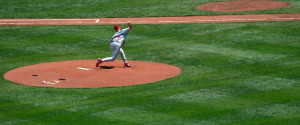Major League Baseball season is now in full swing. As an Australian, I was only properly introduced to Baseball earlier this year on my medical elective, and I’ve quickly come to love “America’s Game”. But of course the major league players of today didn’t get there overnight, they’ve thrown thousands of pitches, spent hours in batting cages and years of their youth at training.
Its this repetitive training that becomes an issue, particularly in the paediatric population. This has become such a problem that terms such as Little League Elbow, have been coined in the medical literature, to refer to elbow problems related to the stress of repetitive throwing.
Known risk factors for injury include pitch count and biomechanics (Fleising and Andrews, 2012; Olsen et al, 2006). Specific parameters include throwing more than 80 pitches per appearance ( 3.85-fold increase), pitching for more than 8 months per year (5.05-fold increase), pitching in more than 100 competition innings in a calender year (3.5-fold increase) and worryingly, throwing frequently when arm was fatigued (36.18-fold increase). Poor technique aka biomechanics is due to a number of social factors including less mastery by individuals and competitive pressure, and is exacerbated by more compliant connective tissue, open growth plates, and underdeveloped muscles in youth players.
As such, many Baseball organisations and Sports Physicians recommend prevention measures to prevent these injuries in developing players. These preventative guidelines for include restriction of the amount of pitching, avoiding pitching through fatigue or pain, and secondary prevention which includes education of coaches, parents and children to enable early diagnosis and management.
However, guidelines are only as good as their compliance, and studies have demonstrated that few coaches follow these guidelines regularly, with only 43% of US coaches correctly answering pitch count and rest periods and only 28% of Japanese coaches complying with similar regulations in Japan. Of course, a number of sociocultural factors are at play here, as these recommendations are often at odds with the competitive nature of sport. On a secondary level, whilst regular medical evaluation has been found to be effective in #injuryprevention in the big leagues, medical supervision is not available in the majority of non-professional, little league, youth baseball clubs. It is therefore difficult for these problems to be picked up early.
Researchers in Japan have come up with an interesting secondary prevention idea, seen in the 2015 Orthopaedic Journal of Sports Medicine (Yukutake et al. 2015). Through multivariate analysis, they have come up with a 6-item checklist that screens for elbow injury in Little League (sensitivity, 0.717; specificity, 0.771). This simple idea is easy to implement, freely available and requires little-to-no medical expertise.
6-item scale (Yukutake et al. 2015)
Importantly, they have designed this screening tool so that it can be easily used by parents, a powerful tool in paediatric injury prevention. “When parents are aware their child is at risk for elbow injury, they can monitor pitch counts themselves and encourage coaches to apply the limits for strictly”. They can also arrange for earlier medical intervention if needed.
It got me thinking; could this type of validated screening become commonplace in other sports?
The end result may be healthier junior players, earlier intervention, prolongation of their playing careers and ultimately, a healthier society. Sounds like a win-win-win to me!
Let us know your thoughts below, or on twitter! @IP_BMJ or @David_Bui_

